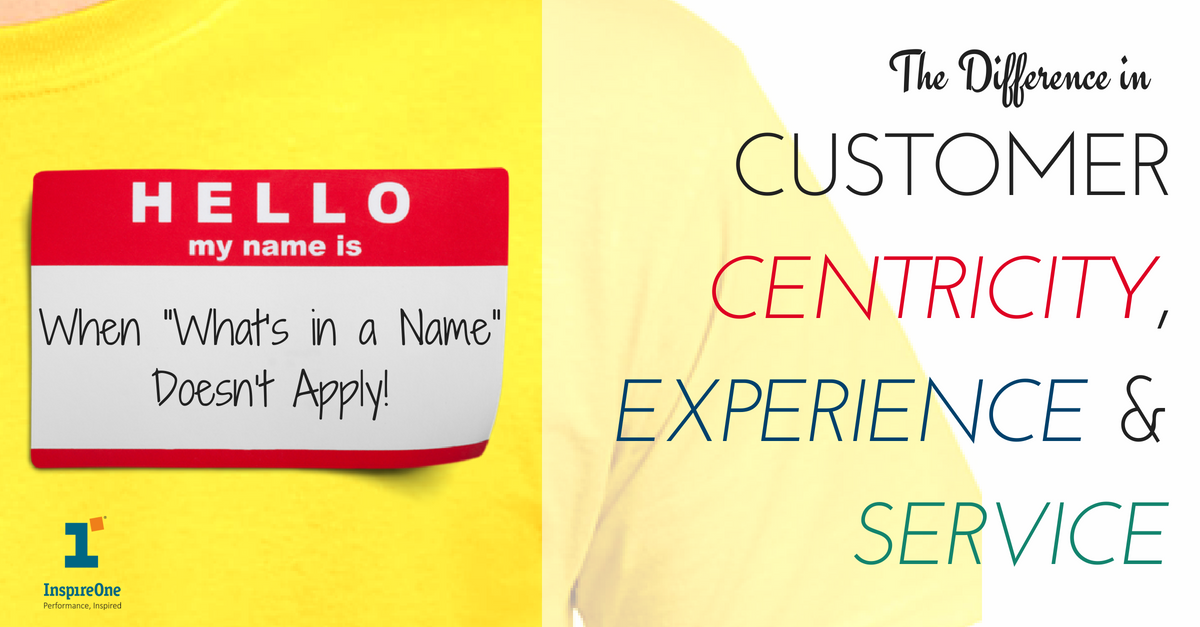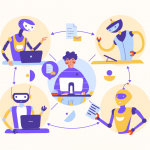This past week, on a flight from Delhi to Mumbai, I heard the two passengers behind me engaged in heated dialogue on how they despised the airlines they were flying and how the experience they had left them wishing they never had to take another flight in their entire lives! The dialogue segued into a debate on customer centricity and how while most organizations thought they had it figured out, they were actually doing nothing to take care of their customers.
What was the most intriguing for me in this debate was the liberal use of the terms customer experience, service and customer centricity, that were very interestingly used interchangeably.
That led me to have some discussions with the people around and with clients to understand if there were others who used the three terms as synonyms for each other. I was surprised at the number of people who do! Professional hazard, I guess, in believing that the difference is so simple and so stark, why wouldn’t everyone know?
When looked at closely, “centricity”, “service” and “experience” neatly capture three separate and very important aspects of how a business merely services the customer or work at earning and keeping the trust of its customers.
Thus, attempting here to distinguish between the three terms, whether as a customer, or as an organization providing the products/services consumed by someone who pays for them, that being the definition of a customer.
If customer experience involves the “what and How ” of the entire customer journey , customer service encompasses the stage of servicing and customer centricity is the “why” that motivates companies to provide said experience. Let’s look at this in depth and with some definitions.
For example, on the flight, when you ask for extra salt, how quickly the steward/stewardess brings you the salt is an example of the customer service you received. How accurately your bill is processed at a restaurant, how patiently and how many of your questions are answered by a call centre agent for a product you purchased, how detailed are the installation instructions given to you when you ask for them are all examples of the customer service provided to you.
Customer service, therefore, is the actions taken to make the customer feel “serviced”, know they have received support for the product / service they purchased. What lies at the crux of great customer service is that , all the customer touchpoints the customer must go through after the purchase are configured and delivered to the customers in the most “service oriented” and value-generating ways. A company’s internal systems must, thus, connect with each other efficiently, and all customer-facing after sales processes need to be well-designed and flawlessly executed.Succinctly, it can be suggested that the experience a customer has with a brand or company may be broken into three basic categories: static, human, and digital.
“Static“ experiences are all about how the customer encounters, uses, and gets benefits from products, retail outlets, newsletters and advertisements, packaging, pricing and coupons, and so on. The product / services features and components.
“Human” experiences happen through “voice to voice” and “face to face” interactions with employees and other representatives of a brand, via meetings with sales representatives, phone conversations, interactive chat sessions, etc.
“Digital“ experiences involve how a customer interacts with websites, phone or computer applications, social media presence, sensors, and other electronic channels.
Continuing with the story from this past week – our flight had been delayed and we had not been informed of the delay. The counters in the lounge and on other display had not been updated, the people at the boarding gate were very matter of fact about the delay. As we sat cooling our heels or worrying about meetings / committmets that had to be re-scheduled, nobody came to make us feel they were concerned about our time being wasted and in fact no one had a clue about when we would take off. When some passengers raised a hue and cry about the delay, the facial expressions and body language of the ground staff was not just non-committal, it conveyed a non-caring attitude.
When we boarded the craft, the crew looked harried and when the pilot announced the delay, he (very conveniently, according to one of the gentlemen in the seats behind mine) passed the responsibility to first a delay in incoming aircraft and then a minor technical snag that was “now repaired”. This is a regular phenomenon said one of the two, indicating that he was a frequent business flier and had been having repeated experiences where the flights delayed and the delays were being handled in a “we really don’t care” attitude.
The irony of the entire situation was that, while the actual product / service was being delivered apathetically, the sales experience was very alluring and created an image and made commitments of “world class flying experience”!
The customer experience that these two gentlemen were having – from the check in counter, to the lounge display, to the boarding gate, to the in-flight crew’s treatment of time – was definitely not something these two customers were expecting based on a completely different promise made at the time of advertising or sale of the service.
What could have brought this on?
This is what brings us to customer centricity. Customer centricity is the motive, the motivation, the ethos for wanting to deliver good customer experiences in the first place.
There’s a reason why South-West airlines is known as the most customer centric airline and appears on that list year on year. Founded in 1967 by industry legend Herb Kelleher, the mission statement reads: “Dedication to highest quality of customer service delivered with a sense of warmth, friendliness, individual pride and company spirit.” When studied, South West has three cornerstones of success.
- Keeping employees first and happy is a cornerstone of Southwest’s success. Southwest empowers its front-line employees and always backs them to make quick decisions that are critical for a good customer experience.
- Always attempt to anticipate a customer’s needs. There is a story of a Southwest gate agent booking tickets of fliers to the next flight to their destination when their flight was grounded elsewhere by bad weather. The agent did this before the fliers even requested it. Being proactive in meeting customer needs always leads to a memorable moment of pleasant experience for the customer.
- Act when an apology is in order. It’s never wrong or ill-timed to offer a genuine apology when things go wrong on your end. Sometimes just an apology goes a longer way to keeping that customer’s loyalty than any monetary solution. An apology by a sincere team member is the mantra that Southwest lives by
Each of those has the customer at its heart.
The intention, or customer centricity, of any company is proven by the delivery of its “entire” customer experience. And it’s the customers themselves who judge the success of the connection. The more customer-centric the organization is across the enterprise, within all departments, involving every employee, the more likely customer experience will be above and beyond the simple transaction.
The symbiotic relationship between customer centricity, customer service and customer experience relate to the similar notion of trustability. There are many definitions of the word “trust” when it comes to business dealings, but it can be efficiently summarized in terms of (1) competence, (2) good intentions, and (3) proactivity. In other words, earning the “extreme trust” of customers requires:
- Doing things right (competence)
- Doing the right thing (good intentions)
- Proactivity
Another way to express these requirements would be to say that earning the extreme trust of customers requires:
- Delivering a good customer experience (competence)
- Being customer-centric (good intentions)
- Doing both without being asked (proactivity)
Research already shows that being more trustable toward customers increases profitability. Think about it this way: Your customer’s experience is the result of what your company does and how proactive you are about doing it, but customer centricity is what’s in your company’s heart.
Is This Only for the Airlines Industry?
No.
Any organization, therefore, that exists will find itself needing to take care of all three –
- Customer Centricity – How do we look at the work we do through our customer’s lens?
- Customer Service – How are we solving our customer’s problems?
- Customer Experience – What experience are we creating for and leaving them with?
Hope you enjoyed our article, for more of such stories and views on service, leadership, organizational and sales development subscribe to the InspireOne blog.
Have you had a customer service experience that you would like to share?
Please do not hesitate to connect with us and we would gladly cover your story in our next articles.







